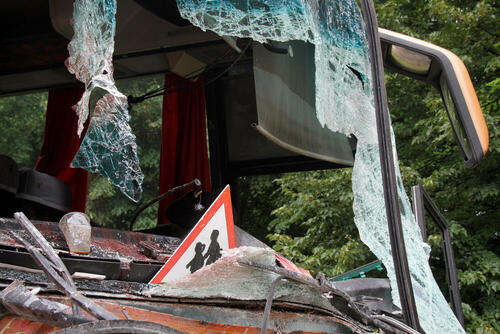That's one of the recommendations in a recent TØI report on driver and road safety in Europe and Norway, which was presented at Europe's largest bus fair Busworld in Brussels on October 10, 2023. The report was commissioned by the Public Transport Association.
In the report, researchers provide an overview of the status of road safety in bus transport, and potential measures to improve road safety in buses; for drivers, passengers and road users outside the bus. The report is intended to provide decision-makers and purchasers with a basis for setting effective and relevant requirements for increased road safety
Based on a systematic literature analysis of previous research, the researchers recommend that the following measures be required to be mandatory in bus transport:
- Fleet management systems to facilitate smooth driving style
- Safety culture measures
- Safety Management Systems
- Crash protection for bus drivers
- With regard to the last point, Crash protection for bus drivers, Norway have recently taken the lead internationally and introduced a legal requirement to this effect. However, there are no specific safety standards that are specially adapted to buses. We recommend that a separate European standard for crash safety in buses should be developed, which is specifically adapted to the use of such vehicles, says Tor-Olav Nævestad, Chief Research Sociologist at TØI.
Call for the same requirements for safety culture and safety management as in aviation, the maritime sector and railways
There is generally less focus on safety culture and safety systems in the road sector compared to other transport sectors. The reason is that transport companies in the road sector do not have the same legal requirements for safety management systems as in aviation, maritime and rail. However, separate national requirements for this can not be introduced in road transport due to EU rules on equal conditions of competition for transport companies. The solution is for third parties, such as transport buyers, to demand this, and the report aims to facilitate this.
- Despite the lack of legal requirements, several bus companies are already working systematically on safety management systems and safety culture. This has yielded positive safety results. The same applies to systematic work with fleet management systems that facilitate a smooth driving style. A soft driving style can prevent both traffic accidents and passenger injuries on board the bus, which are not caused by traffic accidents. The measure is also economically profitable and can result in lower fuel costs, explains Nævestad.
FACTS
Safety management systems consist of formal procedures and measures that enable organizations to work systematically with security, such as identifying risks through formal risk analyses, developing and implementing corrective measures (e.g. procedures, training), defining roles and responsibilities, regular monitoring of status, etc.
Safety culture deals with the informal aspects of safety, or "what people actually do" and refers to common and safety-relevant ways of thinking and acting. Safety culture is often measured by management's and employees' commitment to safety, and perceptions of whether aspects of safety management systems are "alive" and relevant.
Text by Hanne Sparre-Enger, communications manager at TØI the Institute of Transport Economics
Photos: Shutterstock






